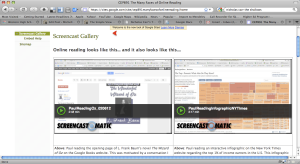As a graduate student, I have thought a good deal about the nature of student-professor dynamics, and about the investment one makes or feels in students when, like, you, they are already grown up. It’s easy to feel invested in children because, well, they’re children. But what is it that graduate student advisors and instructors feel toward their students when they succeed? Pride seems a little paternalistic or even a little presumptive — can professors really take credit for students’ achievement at this level? Last week, I found myself thinking about these questions when one of my students earned some much-deserved recognition for work she did with colleagues in a class I lead last summer.
A Master’s student whom I taught in the MAET Overseas cohort in Ireland contacted me via email. She is currently taking a literacy methods course and as an art teacher, she was unsure about her approach to a literacy-focused research project. We chatted for about 45 minutes, got caught up on recent goings on, and had a very constructive conversation about how she might proceed with her assignment. During our discussion, she also told me that she had decided to present a research poster, developed with colleagues during our summer courses in Dublin, at a graduate student conference at MSU. I was absolutely delighted by her initiative and wished her the best. The poster, which reviewed extant literature on parent-teacher miscommunication also offered practical solutions for building better home-school partnerships by using digital tools. As their instructor — I was totally impressed by the work for its intellectual rigor and its applicability to classroom practice. During our open poster review session in Ireland, other members of the overseas MAET community reviewed it, and loved it, too. The students’ work generated quite a buzz of discussion around this very important issue.
And so, I was simply delighted to learn that judges at the graduate student conference also saw great value in this work. My student and her colleagues who co-authored the work were honored with one of five poster session awards for research excellence! Hooray! Hooray!
And then, I started to wonder why I was taking such delight in their success. I didn’t create the poster. I didn’t write a single word that went on it. I certainly didn’t present it — in Dublin, or in E. Lansing. So why was I feeling so pleased? Why, even now, as a teacher of teachers, do I derive such joy from their achievements? In thinking about this, I have come to realize that the best I can do as a graduate student instructor is to create opportunities and learning structures that enable excellence to flourish. Come to think of it, this has always been what I have tried to do, whether teaching young children, adolescents or adults. Although there is always content that needs to be communicated from me to students, the truth is, that in most cases, I mostly try to frame the learning activity and get out of the way so that students can create things.
And so, I guess the delight I took in this poster session award was deeply connected to a feeling that the activity itself had some value and that the learning ecology in which it was developed allowed these students to show the world their best. In some way, I guess there is delight to be taken in the knowledge that work I have done behind the scenes created a stage on which others could succeed.
I offer my sincere congratulations to Blair, Pilar, Jillian and Laura — and also my thanks, because their successes have prompted me to reflect on my work as a teacher educator. Always learning…



